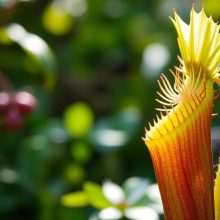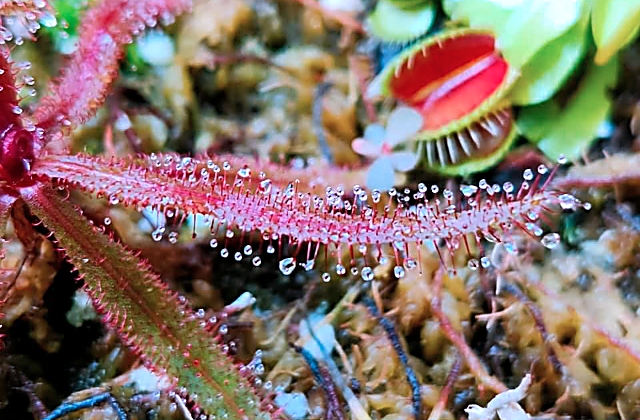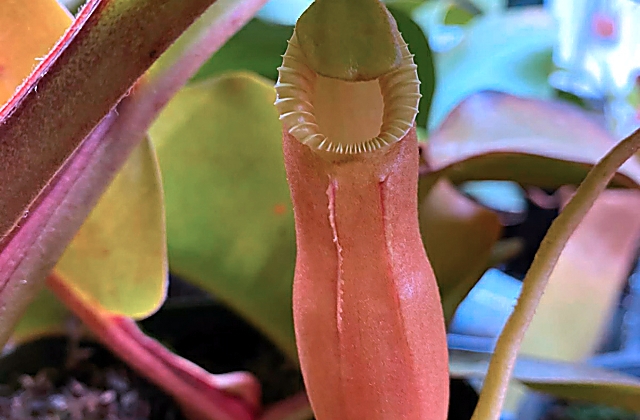Butterwort: The Carnivorous Plant You Need to Know
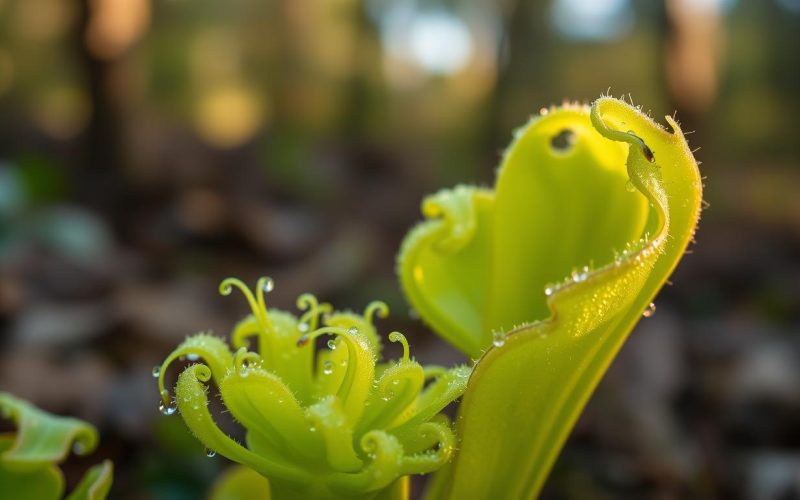
Explore the amazing world of Pinguicula, a group of carnivorous plants that fascinate many. Butterworts are unique and challenge our views on how plants survive. They have evolved special ways to live in places with little nutrients.
Butterworts are found in many places, including North, Central, and South America, Europe, and Asia. Their sticky leaves are clever traps for insects. This makes them one of the most interesting plants in nature.
The name “butterwort” might seem strange, but it comes from their leaves’ greasy feel. These plants have a clever way to catch and digest insects. It shows how nature solves problems in amazing ways.
Key Takeaways
- Butterworts are fascinating carnivorous plants found across multiple continents
- Pinguicula species use sticky leaves to trap and digest insects
- These plants thrive in nutrient-poor environments
- Butterworts represent a unique adaptation in plant survival strategies
- The plants play a crucial role in their native ecosystems
What Is Butterwort?
Butterwort, also known as Pinguicula, is a group of fascinating insect-eating plants. They capture the hearts of plant lovers everywhere. These plants have special ways to survive that make them stand out.
The world of butterwort plants is full of variety. They are found in different places around the globe. These plants are part of a special family that thrives in tough environments.
A Closer Look at Butterwort Characteristics
Butterwort plants have unique features that make them special:
- Soft, sticky leaves that trap insects
- Rosette-like leaf formation
- Compact size, from small to medium
- Vibrant colors like green, purple, and yellow
Global Distribution of Pinguicula
Pinguicula species are found in many places. They live in different ecosystems across continents. You can find them in:
- North America’s temperate areas
- Central and South America’s tropical zones
- Europe’s mountainous regions
- Asia’s subtropical areas
Each butterwort has special traits to survive in its home. This shows nature’s amazing design and strength.
The Science Behind Carnivorous Plants
Carnivorous plants are one of nature’s most fascinating survival strategies. They have developed unique ways to get nutrients in poor soil. Butterwort is a great example of these amazing plants.
Butterwort, also known as Pinguicula, is a special type of carnivorous plant. It has evolved incredible ways to catch prey. This helps it survive in environments where food is scarce.
How Butterwort Captures Prey
Butterwort’s capture mechanism is simple yet effective. Its leaves have sticky, glandular surfaces that attract and trap insects. The process involves several steps:
- Secretion of a viscous, protein-rich liquid
- Attracting insects with a shiny, wet appearance
- Immobilizing prey upon contact with sticky leaves
Digestive Processes
After trapping an insect, butterwort starts a complex digestive process. Special enzymes break down the prey. This way, the plant absorbs nutrients like nitrogen and phosphorus, which are hard to find in its habitat.
- Enzyme secretion begins within minutes of prey capture
- Soft body parts of insects are quickly dissolved
- Nutrients are absorbed directly through leaf surfaces
This amazing adaptation shows how carnivorous plants like butterwort survive in tough environments.
Different Species of Butterwort
The world of butterwort species is full of fascinating plants in the Pinguicula genus. These perennial herbs come in all sizes and shapes. They show nature’s amazing design, from tiny plants to big ones.
Pinguicula plants are special carnivorous plants. They have unique traits that make them stand out. Their ability to catch and digest insects is truly remarkable.
Pinguicula Moranensis: A Tropical Gem
Pinguicula moranensis is found in Mexico and Central America. It’s a vibrant plant with:
- Bright pink to purple flowers
- Sticky leaves to trap insects
- Adaptability to humid environments
Pinguicula Gigantea: The Large Butterwort
Pinguicula gigantea is known for its large size. It has:
- Large leaves up to 6 inches
- Strong carnivorous abilities
- Thrives in tropical areas
Unique Features of Butterwort Species
Every Pinguicula species has its own special traits. Some have wide leaves, others have long, narrow ones. Their colors vary from green to reddish, showing how they adapt to different places.
Growing Butterwort Indoors
Adding insectivorous plants like butterwort to your indoor garden can be exciting. These plants need special care to grow well indoors. With the right care, you can enjoy their unique features.
Ideal Conditions for Growth
Butterwort plants need certain conditions to thrive. They prefer:
- Bright, indirect light
- Temperature range between 60-80°F (15-27°C)
- High humidity levels (50-70%)
- Well-ventilated spaces
Container Choices
Choosing the right container is key for butterwort care. Look for containers that offer:
- Good drainage
- Shallow depth (4-6 inches)
- Clear or translucent materials
- Enough space for root development
Watering and Feeding
Watering is crucial for these plants. Butterworts need very little water. Use distilled or rainwater and keep the soil moist but not too wet. They get nutrients from insects, so no need for regular fertilizers.
Butterwort care is all about finding the right balance of moisture and light. By understanding their needs, you can grow these interesting plants indoors.
Outdoors Care for Butterwort
Butterwort plant cultivation needs special care when grown outdoors. Knowing the right environment helps these plants thrive in nature.
To care for butterworts outdoors, create a habitat like their natural home. These plants need specific conditions to grow well and catch prey.
Best Soil Types for Butterworts
Choosing the right soil is key for butterwort survival. They need poor, draining soils that match their wetland homes.
- Use a mix of 1 part peat moss and 2 parts perlite
- Avoid rich, organic potting soils
- Maintain an acidic soil pH between 5.0 and 6.5
- Ensure excellent drainage to prevent root rot
Sunlight Requirements
Butterworts need careful light to thrive. Direct sun can harm them, so they need the right spot.
- Provide bright, indirect light
- Protect from intense midday sun
- Aim for 4-6 hours of gentle morning or filtered sunlight
- Use shade cloth in hot climates to prevent leaf scorching
Good outdoor care for butterworts includes the right soil, light, and understanding their needs.
Common Myths About Butterwort
Butterwort, a fascinating member of carnivorous plants, often faces many misconceptions. These myths can stop people from growing these plants. Knowing the truth helps gardeners grow and enjoy butterwort.

Growing butterwort means clearing up several common myths. This can help avoid wrong care and maintenance. Let’s look at the most common misconceptions:
- Myth: Butterwort needs constant insect feeding
- Myth: These carnivorous plants survive only in tropical environments
- Myth: Butterwort requires extremely wet conditions
Separating Fact from Fiction
Butterwort plants are more adaptable than many think. They are carnivorous but don’t live only on insects. They can make their own food like other plants and use insects as extra food.
The Real Truth About Care
To grow butterwort well, you need to know their specific needs. These plants do best with:
- Moderate humidity levels
- Indirect sunlight
- Well-draining soil mixtures
- Careful watering techniques
By clearing up these myths, gardeners can grow healthy butterwort plants. This is true in many different places.
Pests and Diseases That Affect Butterwort
Insectivorous plants like butterwort need special care to stay healthy. It’s important to watch your plant closely to avoid disease problems. This is key for growing your carnivorous plant well.
Butterwort plants face many challenges that can harm them. Knowing these issues helps protect your insectivorous plants.
Identifying Common Issues
Butterwort owners should look out for these signs:
- Yellowing or browning leaves
- Unusual spots or discoloration
- Wilting or stunted growth
- Fungal growth around roots
- Insect infestations beyond normal prey capture
Treatment Options
Effective treatment for butterwort health problems needs a gentle touch:
- Remove affected plant parts carefully
- Adjust humidity and light conditions
- Use sterile tools when managing plants
- Maintain proper watering techniques
- Isolate infected plants to prevent spread
Good butterwort care means staying ahead of problems. Watch your plant’s environment and act fast on health issues. This way, your carnivorous plant will do well.
The Role of Butterwort in Ecosystems
Carnivorous plants, like butterwort, are key in unique environments. They show nature’s clever ways to survive. These plants live in places where food is hard to find.
- They control insect numbers in poor food areas.
- They help move nutrients around in tough places.
- They add to the variety of small homes in nature.
Benefits of Carnivorous Plants
Butterwort and other carnivorous plants have special tricks to live where others can’t. They catch and eat small bugs. This way, they get nutrients that are hard to find.
Butterwort’s Contribution to Biodiversity
Butterwort’s special traits make them vital in wetland plants. They help create homes for many creatures. They keep the balance in places with little food.
Now, people are working hard to save these amazing plants. They help keep nature’s variety alive and teach us about how ecosystems work.
Butterwort in Popular Culture
Carnivorous plants, like butterworts, have always fascinated people. These plants, part of the Pinguicula species, have made their mark in media and books. They spark curiosity about how they survive.
Entertainment has started to notice the interesting nature of butterworts and other carnivorous plants. Nature documentaries often show how these plants catch and eat insects. Shows like National Geographic have segments on these plants’ unique ways of hunting.
Representation in Media
- Nature documentaries featuring butterwort’s unique hunting techniques
- Scientific television shows exploring carnivorous plant adaptations
- Botanical photography exhibitions showcasing Pinguicula species
Butterworts have also inspired writers and scientists. Scientific papers often talk about their amazing adaptations. Books and guides about plants give deep insights into carnivorous plants, with butterworts getting special attention.
Butterwort in Literature
- Scientific research papers detailing Pinguicula species
- Botanical field guides exploring carnivorous plant ecosystems
- Nature writing that highlights the unique survival strategies of butterworts
Our interest in butterworts shows how much we love learning about plants. From TV to books, these plants keep us amazed with their special abilities.
How to Propagate Butterwort
Propagating Pinguicula is exciting for plant lovers. These unique carnivorous plants can be grown in many ways. This makes it fun to expand your collection.
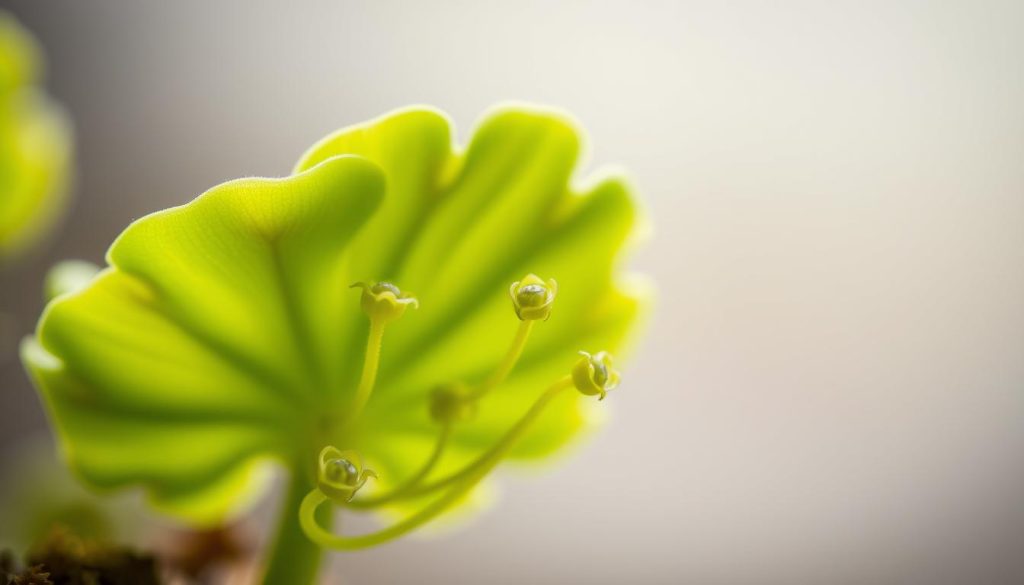
To successfully propagate butterwort, you need to know the right methods. These methods help gardeners grow more Pinguicula plants.
Leaf Propagation Techniques
Leaf pulling is a reliable way to propagate butterwort. Here’s how to do it right:
- Select healthy, mature leaves from the parent plant
- Gently remove leaves with their base intact
- Place leaves on a moist, nutrient-poor substrate
- Maintain high humidity around the leaves
- Wait for new plantlets to develop from leaf bases
Division and Root Propagation
Plant division is another good way to multiply Pinguicula. When repotting, separate healthy root clusters. This creates new plants.
Essential Tips for Growth
- Use specialized carnivorous plant soil mixtures
- Maintain consistent moisture levels
- Provide bright, indirect light
- Repot plants every 1-2 years to refresh nutrients
- Keep temperatures between 60-80°F for optimal growth
By following these care tips, gardeners can grow their Pinguicula collection with ease.
Purchasing Butterwort: Where to Buy?
Looking for the right butterwort for your collection takes some effort. It doesn’t matter if you’re new to plants or have been growing them for years. Knowing where to buy these plants is crucial for your gardening success.
There are many places to buy butterwort, each suited to different needs. It’s important to choose a reliable seller that offers healthy plants.
Online Retailers: Expanding Your Options
Online shopping has changed how we get plants. Specialized websites have a wide range of butterworts that local stores might not have.
- Carnivorous plant specialty websites
- Dedicated online plant marketplaces
- Botanical gardens with online stores
Local Nurseries: Personal Touch and Immediate Inspection
Local nurseries offer benefits for growing butterwort. You can see the plant in person and get advice from experts.
- Check local botanical centers
- Visit specialized garden shops
- Attend plant exchange events
When buying butterwort, look for plants with bright leaves and strong roots. Both online and local stores can offer great plants for your collection.
Butterwort as a Houseplant
Adding a butterwort to your home turns a regular space into a unique ecosystem. These plants are not just pretty. They are carnivorous, catching insects, making them a fascinating conversation piece.
Butterworts are easy to care for, perfect for both new and seasoned gardeners. They help control pests naturally. Their beautiful, sticky leaves add elegance to any room.
Butterworts are loved for their scientific interest and simplicity. They need bright, indirect light and easy care. Displayed on a windowsill or in a plant collection, they bring wonder to your home.
Why Choose a Butterwort?
Butterworts are striking and catch insects naturally. They challenge what we think about plants. They offer an educational experience, connecting us to nature’s most innovative plants.

